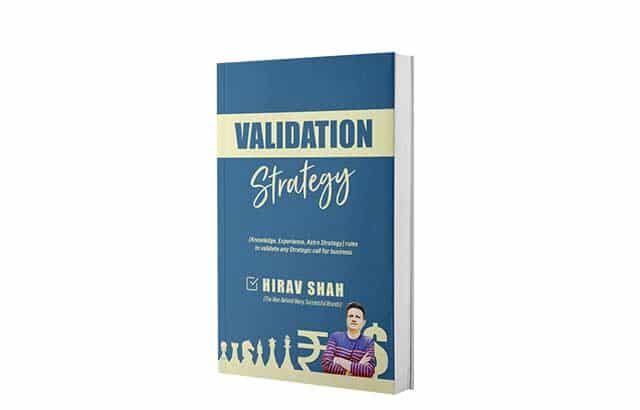Table of Contents
🔍 The Busy Trap vs. the Profit Truth
You wake up early, dive straight into emails, manage team issues, attend three back-to-back meetings, resolve a client crisis, fire off proposals, follow up on payments—and before you know it, it’s 9:00 PM.
You’re exhausted.
You’re busy.
But are you actually… earning?
This is the uncomfortable truth most entrepreneurs ignore:
Being busy doesn’t mean you’re making money.
You may know your monthly revenue, your expenses, even your profit margin—but do you know how much you’re earning per hour?
According to business strategist Hirav Shah, this one number can shift the entire trajectory of your business.
Not just because it reveals how efficient you are—but because it forces you to confront how you spend your time, what’s draining your energy, and which decisions are silently killing your growth.
“Revenue shows what your business earns. But hourly income shows what you truly earn—and that’s the number that reveals whether you’re building wealth or just running in circles.”
— Hirav Shah | Business Strategist
✳️ Section 1: Why Hourly Income Is a Game-Changer
Most entrepreneurs wear “busyness” like a badge of honor.
The 12-hour grind. The 7-day hustle. The sleepless nights.
But here’s the harsh truth—no investor, no partner, and no bank rewards you for hours worked. They only care about outcomes.
This is where hourly income becomes your silent truth-teller.
Let’s say you made ₹3,00,000 profit last month and you worked 240 hours.
That means you earned ₹1,250 per hour.
Now ask yourself:
- Was that worth it?
- Could you have earned the same by working fewer hours with smarter delegation?
- Could you have made more by eliminating distractions?
Hourly income doesn’t lie.
It shows you exactly how much your time is worth. And more importantly, it shows you where you’re leaking time and money without realizing it.
“When founders calculate their hourly income for the first time, most are shocked. Not by how little they earn—but by how much of their day is wasted on things that don’t move the needle.”
— Hirav Shah
This number also uncovers the true health of your business model. Because a business that only works when you do—isn’t scalable. It’s just a job wearing a fancy title.
✳️ Section 2: How to Calculate Your Actual Hourly Income
So, how do you figure out your real hourly income?
Most people confuse turnover with take-home, or workload with worth. But if you want clarity, here’s a simple formulato start with:
✅ The Hourly Income Formula
Hourly Income = (Net Profit + Owner’s Salary + Personal Benefits) ÷ Total Hours Worked
Let’s break that down:
- Net Profit = Total income minus all business expenses
- Owner’s Salary = What you’ve paid yourself (if you take a fixed draw)
- Benefits = Any personal perks: car, travel, insurance, etc.
- Total Hours Worked = Time you actively spent managing, running, and working in the business
🧮 Example:
You ran your business last month and:
- Earned a net profit of ₹2,00,000
- Paid yourself a salary of ₹80,000
- Had perks worth ₹20,000 (like fuel, meals, internet, subscriptions)
- Worked 240 hours (approx. 8 hrs/day × 30 days)
Now calculate:
Hourly Income = (₹2,00,000 + ₹80,000 + ₹20,000) ÷ 240 = ₹300,000 ÷ 240 = ₹1,250/hour
That’s your real worth per hour.
“When you know this number, you start making decisions differently. You stop saying yes to low-paying tasks and start focusing only on high-ROI activities.”
— Hirav Shah
🧪 Try This Exercise Right Now:
- Write down your net profit from last month
- Add your salary (if any)
- Add personal benefits your business covers
- Estimate total hours you worked
- Divide the total income by hours
That’s your income-per-hour reality.
Not what you tell others. Not what your revenue reports say.
But what your time is truly worth.
✳️ Section 3: What the Hourly Rate Reveals About Your Business
Once you calculate your real hourly income, something powerful happens:
You stop seeing your business as just a money machine—and start seeing it as a time-value engine.
Let’s decode what this number reveals:
1. 💰 Pricing Gaps
Are your products or services priced high enough to justify your time?
If your hourly income is ₹300, but you’re spending 5 hours on a ₹1,000 client, you’re actually losing money.
“Cheap pricing is expensive in the long run. It costs your time, energy, and future.”
— Hirav Shah
2. 🧹 Task Waste
Are you spending time on admin, follow-ups, coordination, or customer support—things that don’t grow your business?
Let’s say you’re worth ₹2,000/hour.
Why are you doing ₹200/hour work?
Either outsource it or automate it.
3. 👥 Team Effectiveness
Is your team actually saving you time?
If you hired 3 people but are still working 12 hours a day, something’s wrong.
Your hourly income helps you measure whether your team is helping or hindering growth.
4. 📦 Product or Service Alignment
Which services or products give you highest return per hour?
Some offerings are volume-based (high effort, low margin), others are value-based (low effort, high margin).
The hourly income metric forces you to rethink your focus.
5. 🔁 Personal Burnout Check
If your hourly income is low and you’re working nonstop, that’s not entrepreneurship—it’s exploitation.
It’s time to pivot your model, not push harder.
“A business that thrives only when you exhaust yourself isn’t sustainable. It’s a trap dressed as a title.”
— Hirav Shah
✳️ Section 4: How Founders Fall into the ‘Time Trap’
Most entrepreneurs aren’t lazy—they’re simply distracted.
They get trapped in a loop of doing everything, believing “if I don’t do it, it won’t be done right.”
But that mindset creates a self-employed prison—not a business.
Let’s decode the biggest time traps:
🔻 1. Doing It All Yourself
From design to delivery, from sales calls to billing—if you’re doing every task, you’re spending your time where you should be spending money (by hiring).
“Delegation isn’t a luxury. It’s a growth strategy.”
— Hirav Shah
🔻 2. Glorifying Hustle over Outcome
Many founders equate long hours with success. But working 14 hours a day without clarity doesn’t mean progress—it often means poor prioritization.
🔻 3. Saying Yes to Every Meeting
You don’t need to attend everything. Meetings without a purpose or decisions waste your most precious resource—time.
🔻 4. Emotional Attachment to Low-ROI Work
You enjoy tweaking your website or replying to every comment. But that doesn’t mean it grows your business. Focus on what only you can do.
🔻 5. Operating Without a Time Budget
Just like you track your money, track your time:
- Where is it going?
- What return is it giving?
- What can be delegated, automated, or deleted?
“You don’t need more hours. You need more value per hour.”
— Hirav Shah
✳️ Section 5: Use the 6+3+2 Formula to Increase Your Hourly Income
This isn’t just about saving time.
It’s about restructuring your business to make every hour profitable.
Business strategist Hirav Shah suggests using the 6+3+2 Success Formula as a daily filter to increase your per-hour ROI:
✅ 6 Core Pillars
- Hard Work
Yes, hard work matters—but it must be aligned with high-return actions. Don’t just work more. Work on what moves the needle. - Mindset
Stop romanticizing exhaustion. Start valuing your time. Shift from “I have to do everything” to “What’s the best use of me today?” - Strategy
Structure your week in blocks: client work, thinking time, team meetings, execution. Without strategy, time bleeds. - Skills
Upgrade your sales, marketing, leadership, and pricing skills—so you can charge more for the same time. - Execution
Ideas are cheap. Execution is everything. Build a daily 3-task execution model. - Luck (Energy & Timing)
Pick the right time to launch, decide, negotiate, or expand. Your birth chart and cosmic alignment can support smarter timing through astro strategy.
“The wrong action at the wrong time can burn hours, days, and months. Time has energy. Use it wisely.”
— Hirav Shah
✅ 3 Entrepreneurial Traits
- Hunger
Refuse to settle. Hunger drives you to question your worth and improve it. - Dedication
Say no to distractions. Focus is the highest currency in an attention-deficit world. - Consistency
Do a time-value check every Sunday. See what’s helping and hurting your hourly rate.
✅ 2 Growth Drivers
- Innovation
Offer something new, exclusive, or bundled that gives more value with less time. - Marketing
Attract better-paying clients, not just more clients. Marketing determines your price position.
✳️ Section 6: Tools to Track Your Hourly ROI
You can’t improve what you don’t measure. Start by tracking your time with simple tools—and review weekly.
🛠️ 3 Easy Tools to Start With
- Google Sheets
Create a simple time vs. task tracker. Add columns for:
- Task
- Time taken
- Outcome (₹ or Result)
- ROI (High/Medium/Low)
- Toggl (Free Time Tracker)
Track tasks in real-time and get visual reports on where your day goes. - RescueTime / Clockify
Track screen activity to identify digital time-wasters (social media, switching tabs, etc.)
📅 Weekly Review Ritual
Ask yourself every Sunday:
- What made me the most money this week?
- What cost me the most time for the least result?
- What should I stop doing next week?
- What can I automate, delegate, or eliminate?
“Tracking your time isn’t micromanagement. It’s self-respect.”
— Hirav Shah
✳️ Section 7: Red Flags You’re Earning Less Per Hour Than You Think
Let’s face it—most business owners are so focused on keeping the business running that they rarely stop to assess what their time is actually worth.
But deep down, you might already feel something’s off.
So how do you know if your real hourly income is far below your potential?
Here are five undeniable red flags:
🚩 1. Your Calendar Is Full, but Your Bank Balance Isn’t
You have meetings lined up. Calls back-to-back. Client work all day. But at the end of the month, your income doesn’t reflect your effort.
That means you’re busy, not profitable.
This is the most common trap for small business owners and solo entrepreneurs. You confuse “being needed” with “being rewarded.”
Hirav Shah says: “If your effort isn’t showing up in your bank account, it’s time to stop and reflect—not work harder.”
🚩 2. You Can’t Take Even a 1-Day Break
If your absence stalls operations, deliveries, or decisions—it means your business isn’t built to run without you.
That’s a major red flag.
It means you’re the system. And your hourly income drops to zero when you’re sick, resting, or away.
True entrepreneurs build systems. They don’t stay trapped inside them.
🚩 3. You’re Afraid to Hire or Outsource
Do you keep thinking:
- “It’ll take too much time to explain to someone else.”
- “It’s cheaper if I just do it myself.”
- “What if they mess up?”
This mindset is costing you heavily. By clinging to tasks you could delegate for ₹200/hour, you’re blocking opportunities to focus on ₹2,000/hour work—like strategy, marketing, or investor relations.
Hiring isn’t a cost—it’s a time buyback investment.
🚩 4. You’re Always Playing Catch-Up
If your to-do list never ends and you’re constantly reacting—rather than planning—you’re not in control of your time or energy.
You’re running your business on urgency, not strategy.
This leads to exhaustion, low-quality decisions, and eventually, burnout.
🚩 5. You Don’t Know What’s Really Making You Money
You offer multiple services. Run various campaigns. Attend endless meetings. But when asked, “Which activity gives you the best ROI?” — you go blank.
That means you’re working without metrics, and probably wasting hours on things that have little or no return.
Hirav Shah explains: “Clarity is your highest form of leverage. If you don’t know where money comes from, you can’t multiply it.”
✳️ Section 8: What High-Earning Entrepreneurs Do Differently
The top 1% don’t have more time than you.
They just use it very differently.
Here’s what high-earning business leaders, founders, and consultants consistently do to keep their hourly income at a premium:
✅ 1. They Say No More Than They Say Yes
The highest-paid entrepreneurs protect their time like gold.
They say no to:
- Non-essential meetings
- Unqualified leads
- Free advice seekers
- Low-ticket clients
Their calendar reflects their value—not others’ urgency.
Hirav Shah’s insight: “Every YES costs you energy, opportunity, and revenue. Use it wisely.”
✅ 2. They Don’t Sell Time—They Sell Results
They move from:
- Hourly billing → Fixed fee or value-based pricing
- Project pricing → Outcome pricing
- Free consultations → Paid strategic sessions
Clients pay for what you solve, not how long it takes.
✅ 3. They Guard Their Focus Ruthlessly
They block time for deep work.
They shut off notifications.
They don’t multitask.
They batch tasks and create space to think.
Their focus is a strategy, not a hope.
✅ 4. They Delegate Everything That Isn’t Growth
They hire experts for:
- Design
- Accounting
- Admin
- Tech support
- Customer service
Why? Because it allows them to spend time on vision, partnerships, expansion, and innovation.
They ask: “Is this the best use of my time right now?”
If not—they hand it off.
✅ 5. They Obsess Over Metrics That Matter
They know their:
- Revenue per hour
- Profit per service
- Cost per acquisition
- Team productivity
- Cash flow forecasts
This data drives every key decision—not emotion or assumptions.
Hirav Shah says: “The best entrepreneurs don’t guess. They know. And that’s how they grow.”
✳️ Section 9: Bonus Strategy – Stop Selling Time, Start Selling Value
Here’s a truth most entrepreneurs realize too late:
Clients don’t care how many hours you work.
They care what result you deliver.
So why charge by the hour?
🎯 Shift From Time-Based to Value-Based Offerings
Instead of this:
“₹1,000 per hour for consultation”
Do this:
“₹15,000 for a 7-day clarity roadmap to increase your revenue by 30%”
The same work. But positioned differently. And paid better.
🧰 Ideas to Productize Your Expertise:
- Consultant: Turn sessions into a strategic framework or paid audit
- Designer: Sell brand kits, templates, or design packages
- Coach: Create a fixed 4-week transformation bootcamp
- Trainer: Offer digital courses, video workshops, or eBooks
💸 Why This Works:
- You move from trading time to creating assets
- You can serve more people with less effort
- Your income becomes scalable and less stressful
- Clients value your expertise—not your stopwatch
“If your income stops when you stop, you don’t have freedom. You have a schedule.”
— Hirav Shah
✳️ Section 10: Create a Daily Business Clarity Ritual (Just 15 Minutes)
If you want to make lasting change, don’t wait for a perfect system.
Start with just 15 minutes of reflection each day.
This simple ritual can transform how you think, decide, and earn.
📅 Nightly Clarity Ritual (5 Questions in 15 Minutes)
Every evening, before bed:
- What activity made me the most money today?
- What felt like a waste of time or energy?
- What can I automate, delegate, or delete tomorrow?
- Did I get closer to my ideal per-hour income?
- What’s my highest-value task for tomorrow morning?
Write it down. Reflect. Adjust.
🌱 Why It Works:
- It removes noise from your day
- Keeps you profit-focused, not task-focused
- Helps you realign your energy with high-value outcomes
- Prevents burnout and restores mental clarity
- Keeps your long-term goals front and center
“Success doesn’t come from big decisions. It comes from small daily reflections done with discipline.”
— Hirav Shah
🧭 Final Closing: Why This One Number Can Change Everything
In business, we track revenue, profit, expenses, growth, customer satisfaction, and even social media followers…
But we often forget to track the one thing that shapes all of it—our time.
When you calculate your real hourly income, you’re not just crunching numbers.
You’re reclaiming your freedom, focus, and future.
This number tells you:
- What’s working
- What’s wasting your time
- What needs to stop
- And what could scale
“Your time is the most expensive currency in your business. If you don’t value it, no one else will.”
— Hirav Shah
So go ahead.
Calculate your worth.
Restructure your day.
And most importantly—never settle for earning less when you have the potential to earn more.
❓ Frequently Asked Questions (FAQs)
Q1. I’m a solopreneur. Does this still apply to me?
Yes. In fact, it’s even more crucial for solopreneurs. Your time is your business. Knowing your hourly income helps you price smarter, plan better, and avoid burnout.
Q2. Should I include passive income or investments in this calculation?
No. This metric is meant for active business income only—the money you earn for your time, effort, and energy.
Q3. What if I don’t track hours? I just work whenever I can.
Estimate an average over 30 days. The goal is clarity, not perfection. Once you see the number, you’ll be inspired to track better.
Q4. What’s a “good” hourly income for a founder?
There’s no fixed benchmark. But if your hourly rate is less than what you’d earn in a job, it’s a sign your business model needs realignment.
Q5. How often should I do this exercise?
Do a full audit once a month. But reflect briefly on your daily time-value every evening (takes 10–15 minutes).
🧪 Interactive Reader Exercise: 3-Day Time Audit Challenge
Ready to test your real-time value?
Here’s a simple challenge that reveals where your time—and money—are really going.
✅ Step-by-Step Guide:
🗓️ Duration: 3 days
📝 Tool: Journal, notes app, or Google Sheet
✍️ Step 1: Track Every Task (In 30-Minute Blocks)
For each half-hour block, note:
- What you did
- How long it took
- Whether it produced income (₹) or was supportive/admin work
🎯 Step 2: Color Code Your Tasks
- 🟩 Green = High-value (direct income, strategy, key decisions)
- 🟨 Yellow = Supportive (email, coordination, follow-ups)
- 🟥 Red = Low-value (scrolling, random tasks, distractions)
🔍 Step 3: Analyze on Day 3
- How much time was Green vs. Yellow vs. Red?
- What will you stop, delegate, or optimize next week?
- What’s your hourly income for these 3 days?
“This small exercise gives you the power to remove waste, refocus your energy, and realign with growth. It’s like a detox—only for your business hours.”
— Hirav Shah
📣 Call to Action
You’ve read the insights.
Now it’s time to act.
If you’ve never calculated your hourly income before—do it today.
If you’re doing it already—optimize it.
Track. Reflect. Realign.
And if you’re ready to transform your clarity into strategy, start with your time.
✅ Want more business clarity frameworks like this?
✅ Stay tuned for upcoming articles by Business Strategist Hirav Shah in Divya Bhaskar Digital’s Business Column—published every Thursday.
About the Writer
This article is authored by Hirav Shah, a globally respected Business Strategist, founder of the world’s first Business Decision Validation Hub and author of 19 strategy books. His 6+3+2 framework and Astro Strategy approach have helped business owners, startups, and CEOs across industries make sharper decisions and achieve breakthrough results.



















